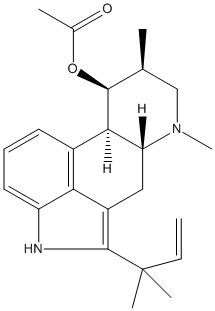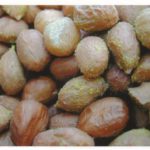Date: 26 November 2013
Secondary metabolites, structure diagram: Trivial name – fumigaclavine C
Copyright: n/a
Notes:
Species: A. fumigatusSystematic name: Ergolin-9-ol, 2-(1,1-dimethyl-2-propenyl)-6,8-dimethyl-, acetate (ester), (8-beta,9-beta)-Molecular formulae: C23H30N2O2Molecular weight: 366.497Chemical abstracts number: 62867-47-4Selected references: COLE RJ ; KIRKSEY JW ; DORNER JW ; WILSON DM ; JOHNSON J C JR ; JOHNSON AN ; BEDELL DM ; SPRINGER JP ; CHEXAL KK ; ET AL. J AGRIC FOOD CHEM; 25 (4). 1977 826-830. Mycotoxins produced by Aspergillus fumigatus species isolated from molded silage.Toxicity: The clavine alkaloids, fumigaclavine A, a new alkaloid designated fumigaclavine C and several tremorgens belonging to the fumitremorgen group were produced by A. fumigatus strains isolated from molded silage. The LD50 of fumigaclavine C was about 150 mg/kg oral dose in day-old cockerels. Calves dosed with crude extracts of A. fumigatus cultures experienced severe diarrhea, irritability and loss of appetite. Postmortem examination showed serous enteritis and evidence of interstitial changes in the lungs; abnormal changes were not found in other tissues.
Images library
-
Title
Legend
-
Aspergillus – Immunodiffusion Test showing stong immunoprecipitin lines against aspergillus.

-
Talaromyces macrosporus- very short heat treatments of dormant ascospores at 85 C are able to activate these spores to germinate within 1 minute. One stage of germination is a very quick bursting of the thinly walled inner cell through the thick ornamented outer cell wall of the spore.
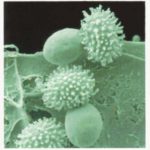
-
RAPD profiles of 14 A fumigatus isolates from Swedish and New Zealand saw mills, generated with primer R108. Mwt markers (lambda with Pst1) indicated by M.
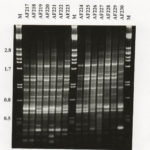
-
These 3 images show non-union of the sternum post-aortic valve replacement as a result of local Aspergillus fumigatus infection. Underlying the sternum is some soft tissue which is presumptively also infection and in the most inferior image, the pericardium is also invoved.
The patient also is diabetic, with rhematoid arthritis and ulcerative colitis and occasionally receives a course of corticosteroids. The wound discharged pus which grew A. fumigatus. It was managed conservatively with itraconazole initally, with failure of therapy over 3 months.
 ,
,  ,
, 
-
CHEF gel of A. fumigatus chromosomes. The electrophoretic karyotype of two isolates of A. fumigatus is shown. The chromosomal bands have been resolved using Bio-Rad CHEF DRII equipment. The sizes of the bands vary between the two isolates and at least five bands have been resolved using the following conditions: chromosomal grade agarose (Bio-Rad) at 1.2 % in 1 x TAE buffer was used; the gel was run with a field strength of 1.8 V/cm for 48 h with a switch time of 2200 s and for 71 h with a switching ramp

-
Aspergillus ear rot and storage mould – Aspergillus flavus and Aspergillus parasiticus can produce aflatoxins are generally known as storage fungi, but they can also cause ear rots in the field. These species are observed as a gray-green, powdery molds and they can be detected in corn because they produce compounds that are fluorescent under black light.

-
Environmental and sick building images. Dirty ventilation intake ducts
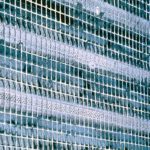
-
A.fumigatus conidium. Scanning electron micrograph of an A.fumigatus conidium showing the fascicles of hydrophobic rodlets covering the surface


